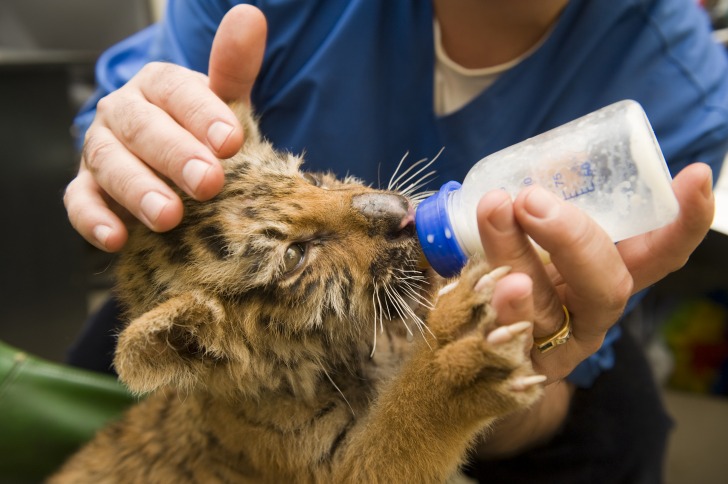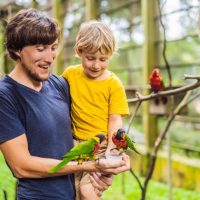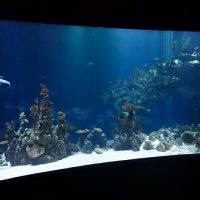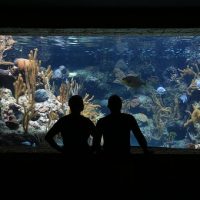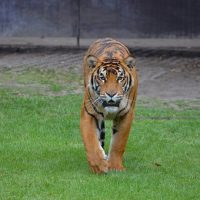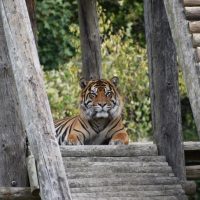The Granite State, otherwise known as New Hampshire, has a lot to offer.
New England in general has long been a place that tourists from all over the U.S. flock to.
One of the reasons for this is the zoos and aquariums in New Hampshire.
And though there are only a few, each of them is a notable attraction that every visit to the state should include.
Contents
Five Best Zoos and Aquariums in New Hampshire
1. Living Shores Aquarium
In the underwater habitats of the Living Shores Aquarium, you’ll see exhibits on otters, cold water trout, silver moony, and more.
The cold water trout exhibit is where you can touch the aquarium’s four stingrays.
Other exhibits include the critter wall, aviary, coral, great barrier, and tropical reefs.
There is also a New Hampshire species exhibit that features yellow perch, largemouth bass, and catfish.
Exhibits aren’t the only notable parts of the aquarium.
In addition, its touch pools hold animals like the Red Gerra fish.
This fish is found in West Asia and lives in ponds, streams, and lakes.
Due to the number of people that like to catch the Red Gerra, it is rare to spot one in the waters.
They may also be hard to find because Asian and European spas often use these fish to treat their clients.
The aquarium also has a Bamboo Shark Touch Pool.
Look out for its residents to use their fins to walk through it.
Residents of this touch pool include Coral Catsharks, White Spotted Bamboo Sharks, Epaulette Sharks, and Brown Banded Bamboo Sharks.
There are both small and large inverted touch pools at the aquarium.
Using only two fingers, you’ll be able to touch the fish in them.
The small invert pool holds animals like feather duster worms, urchins, small crabs, and shrimp.
The large invert pool holds animals like snails, horseshoe crabs, hermits, and Caribbean spiny lobsters.
For a small fee, you can even participate in a Stingray or Lorikeet feeding.
2. Blue Ocean Discovery Center
While the Blue Ocean Discovery Center is only open to the public during the summer, it’s worth planning a vacation around if you want to learn more about aquatic animals.
Most of the center’s tanks house local invertebrates.
The Discovery Center also has a touch tank that holds its larger animals, as well as periwinkles and crabs.
Other attractions at the center include a demonstration of a lobster trap and one that addresses the link between climate change and whales.
One of the exhibits even includes an interactive map that allows you to search for marine debris.
3. Squam Lakes Natural Science Center
The Squam Lakes Natural Science Center is a place where visitors can learn about many animals, including the American Mink, the Broad Winged Hawk, and painted and spotted turtles.
Some of the science center’s most popular exhibits include the Wood Energy exhibit.
Five of the center’s buildings are heated using locally obtained wood that is harvested sustainably.
Life Underground is a unique exhibit you won’t find anywhere else.
It includes a chipmunk burrow that is large enough for a human to walk through.
The exhibit includes views of earthworms and ants.
A microscope is provided so visitors can see the smallest animals that live in the soil.
One of the kid-friendly attractions is the Gordon Interactive Playscape.
They can briefly assume the life of a red squirrel.
The exhibit lets them run through tunnels, climb on logs and rocks and figure out how to escape the predators pursuing them.
This is part of the Gordon Children’s Center.
It’s a two-story barn filled with fun obstacles to navigate, including an underground tunnel, and a huge spider web they’ll have to climb through to complete the course.
Outdoor attractions include the Wetlands Walk.
As a manmade wetland, it is easy and fun to explore.
During the walk, you’ll cross over a stream where you may spot turtles, frogs, and salamanders.
And if you want to relax afterward, head over to Kirkwood Gardens, where you can sit and soak in your surroundings on the bluestone patio.
There is both an upper and lower garden, one that is in the shade and one that is in the sun.
The upper garden is where you can see rhododendrons, ferns, and azaleas.
The lower garden has trees, perennials, and shrubs.
It also has a millstone fountain, a beautiful sculpture, and an old apple tree that often attracts hummingbirds to the garden.
4. Charmingfare Farm
To see the exhibits at the Charmingfare Farm, you’ll have to delve deep into its woodsy area, where you will see animals like bobcats, black bears, and fallow deer.
But for kids, the highlight of a visit to the farm is its petting area, which can be found in the Dairy Discovery Barn.
Visitors to the farm can even choose to go on a horseback ride.
Along the trail route, you will make your way down logging roads that take you right into the forest.
At the beginning of your ride, you may see livestock grazing on the farm’s grass.
But when you enter the forest you may spot animals like wild turkeys, coyotes, and foxes.
On rare occasions, you may even spot a moose.
5. Seacoast Science Center
You’ll find the Seacoast Science Center at Odiorne Point State Park.
Because it is located close to Maine, the Science Center’s exhibits include Our Dynamic Gulf of Maine, The Edge of the Sea, Marine Mammals of the Gulf of Maine, and the Restoring Reefs exhibit.
Our Dynamic Gulf of Maine includes The Lobster Trap, Captured in Currents, Coastal Invaders, Cashes Ledge, and On the Move.
The Edge of the Sea includes the Tide Pool Touch Tank and the Water Table Station.
The main attraction of the Marine Mammals of the Gulf of Maine is Tofu, the Humpback Whale.
You will see Tofu’s skeleton and learn about his journey all over the world.
The exhibit includes his family tree and explains how scientists track whales using their fluke patterns.
The Restoring Reefs exhibit includes living coral habitats, Clownfish, Anemones, Coldwater Corals, Eelgrass, and seahorses.
You can observe them in their natural environments.
The Seacoast Science Center also runs a few programs.
Their Family Nature programs include nature journaling and tide pooling.
You can also participate in Big Fish, Little Fish with your kids.
Some of the more interactive programs are the Eco-Adventure Travel and Wildlife Kayak Tours.
5 Best Zoos & Aquariums in New Hampshire – Summary Table
| Zoos & Aquariums | Address |
|---|---|
| Living Shores Aquarium | 850 Pinkham Notch Road, NH-16, Glen, NH 03838, USA |
| Blue Ocean Discovery Center | 180 Ocean Blvd, Hampton, NH 03842, USA |
| Squam Lakes Natural Science Center | 23 Science Center Rd, Holderness, NH 03245, USA |
| Charmingfare Farm | 774 High St, Candia, NH 03034, USA |
| Seacoast Science Center | 570 Ocean Blvd, Rye, NH 03870, USA |
New Hampshire Safety Overview
READ THE FULL REPORT: New Hampshire Safety Review
Safety Index: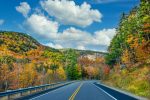
- OVERALL RISK: LOW
- TRANSPORT & TAXIS RISK: LOW
- PICKPOCKETS RISK: LOW
- NATURAL DISASTERS RISK: LOW
- MUGGING RISK: LOW
- TERRORISM RISK: LOW
- SCAMS RISK: MEDIUM
- WOMEN TRAVELERS RISK: LOW
Frequently Asked Questions
When can I see the feedings at Living Shores Aquarium?
Feeding is scheduled on an hourly basis throughout the day.
Reservations for feedings are granted on a first-come-first-serve basis.
Can I get my money back if Charmingfare Farm closes due to weather conditions?
There are no refunds for admission tickets once they’ve been purchased.
If inclement weather closes the farm, you’ll need to exchange your tickets for a different day.
Is outside food allowed at Charmingfare Farm?
Yes, you can utilize the picnic facilities if you bring your own food.
At the farm’s gift shop, you can purchase snacks, drinks, and even ice cream.
Can I gain admission to the Seacoast Science Center without buying admission to Odiorne State Park?
No, since the Seacoast Science Center is on the Odiorne State Park property, you need both a part ticket and a science center ticket for access.
